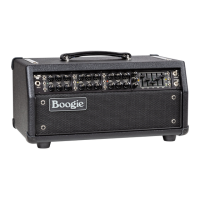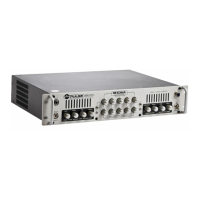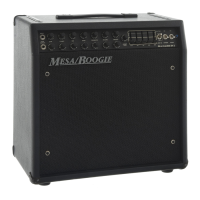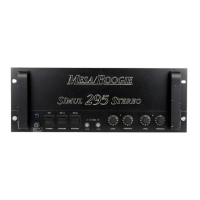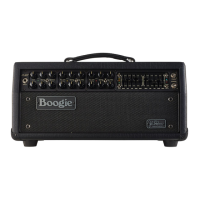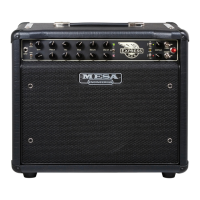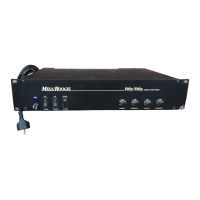FRONT PANEL
THE CHANNELS: MODE BY MODE
The Channels of the MARK FIVE: 35 are each extremely versatile and therefore it is not entirely fair to categorize them as Rhythm
and Lead. Most players will initially assign Channel 1 to some sort of clean sound and Channel 2 to an overdriven chording sound or
a single note solo sound. While there is nothing wrong with this scheme, and in fact the Channels DO lay out nicely for this approach,
it is also true that both Channels are equally adept at all three types of sounds. In other words, Channel 1 can produce great crunch
rhythm and overdriven Lead sounds, and Channel 2 boasts some amazing low gain “threshold of clip” sounds. So the lesson here is
not to label the Channels as to sound style, and perhaps think of them more in terms of their individual gain structure... “lower” and
“higher”. This type of thinking will help you to not limit yourself when searching for sounds and we encourage you to think outside the
box and use your imagination when dedicating the Channels for your needs. The Five: 35 was created to be an instrument of limitless
expression and possesses all the gain and shaping power in its two Channels to take you anywhere you wish to go in the world of Tone.
Here is a “shorter” reference guide to the Channels and how they lay out in terms of gain structure. How you wish to assign them to
your needs is up to you and discovering that… well that’s where the fun begins.
CHANNEL 1
This is the lowest gain of the two Channels in the MARK FIVE: 35. Two Modes CLEAN (switch up) & FAT (switch
center) are structured with lower gain clean sounds being at the forefront of their responsibilities. These two modes are well described
by their names... as in CLEAN produces sweet, sparkling low gain beauty and FAT adds big, lower (frequency-wise), low end and
breathiness to that sound. These two have the greatest headroom, the most dynamic range and Input Stage sensitivity in the entire
amp. They are the least compressed and retain the fastest attack characteristic. They would be considered as being based on “vintage”
architecture.
The medium gain CRUNCH Mode (switch down) is dedicated to pushed, overdriven “Crunch Rhythm” sounds and is the bridge be-
tween the top of Channel 1’s maximum gain region and the taking-off point for Channel 2’s high gain structure. It took no small feat of
engineering to include this super musical, “in-between” Mode in Channel 1’s palette and achieve the correct tapers on critical shared
Controls while still offering a seamless overall response and feel. CRUNCH would stand proud as the ONLY Mode on any amplifier
and adds immense versatility to the arsenal of great sounds in Channel 1.
CRUNCH adds gain across the spectrum but increases gain in the low and medium mids and adds fatness in those regions, which
creates a smoother sound when clipped. This added gain slows the attack a bit, but in turn adds sustain and girth. A balanced dynamic
content makes it work equally well for both broken-up chording and urgent single note soloing. This medium gain and dynamic range
is the perfect transition between a “vintage” gain structure where overdriven clean sounds are the maximum available, and a modern
“high gain” preamp like Channel 2’s Modes where the added tube stages more fully saturate the signal, slow the attack and compress
the signal even more. CRUNCH is likely to be all the gain/overdrive aficionados of the more traditional gain structure will ever need.
Again, remember that in all three of Channel 1’s Modes, you will likely hear more power section drive and saturation than you may be
accustomed to in higher wattage power sections. This may warrant a more conservative application of the preamp’s GAIN control to
achieve the sounds and the attack characteristics you are used to in those higher wattage amps. So keep that in mind when dialing
in the three Channel 1 Modes for your applications.
PAGE 10
CLEAN
CRUNCH
FS
MK IIC+
MK
IV
XTREME
GAIN TREBLE
MID BOOST
MID PRESENCE MASTER
SOLO 1
SOLO 2
BASS
FAT
EQ ON
EQ PWR
O
O
EQ FS
SPKR
ON
CLOSED
BACK
VINTAGE
CabClone™
D.I.
SPKR
OFF
EQ ON
EQ FS
CAUTION: Unplug
power before
servicing
120 V~
60 Hz
2 A
2 A
SLO
BLO
AMPLIFIER
44YV
HEADPHONERETURNSEND 4 OHM 8 OHM4 OHM
REVERB
CH 2 CH 1
MARK FIVE: 35™
VACUUM TUBE
AMPLIFIER
MADE IN PETALUMA, CA
WITH THE WORLD’S
FINEST MATERIALS
80Hz 240 750 2200 6600
35 W
25
10 W
35 W
10 W
FX
SPEAKERS
LIFT
GROUND
OPEN
FOOT SW.
TUBE GUIDE
6 x 12AX7
4 x EL 84
PATENTED
6,621,907
6,724,897
7,602,927
25
POWER
ON
ON
STANDBY
MARK
5
THIRTY-FIVE
™
INPUT
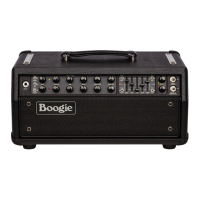
